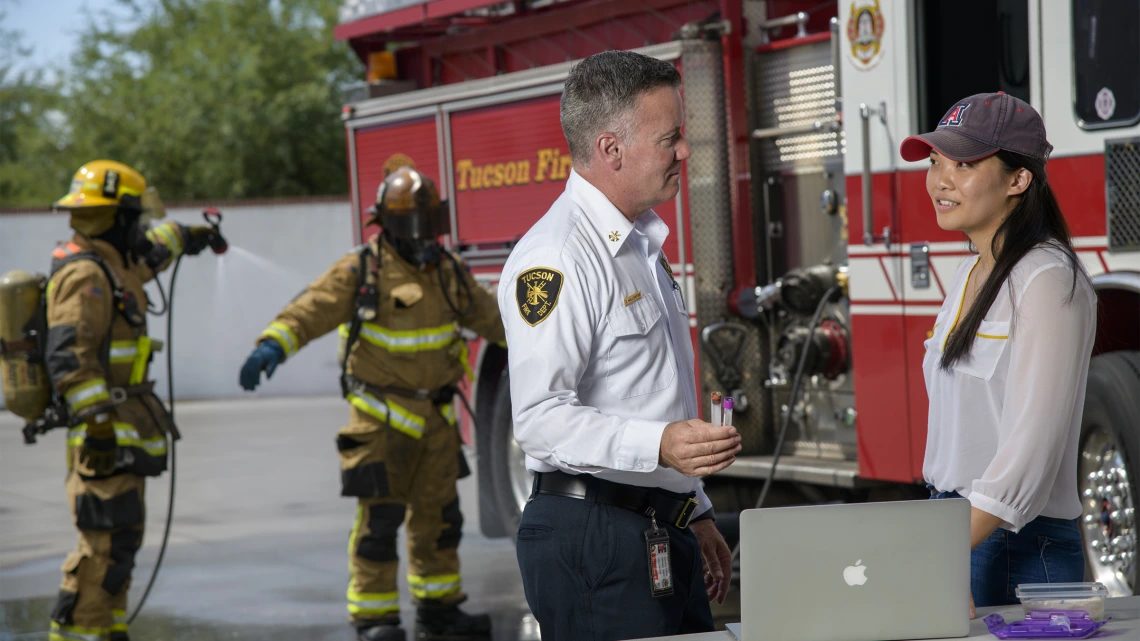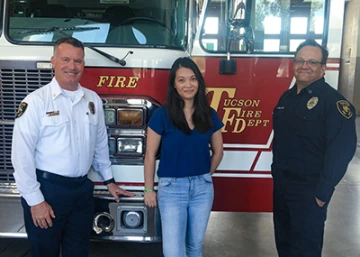Health Sciences Researchers Find Firefighters Battle More Than Just Flames
Fighting fires for a living is one of the most dangerous jobs, according to the U.S. Bureau of Labor Statistics. But after the flames are out, danger remains.

Alesia Jung, a doctoral student in epidemiology at the UArizona Mel and Enid Zuckerman College of Public Health, is project coordinator for the Fire Fighter Multicenter Cancer Cohort Study and works directly with firefighters in Tucson and beyond.
Cancer rates are higher among firefighters, compared to the general U.S. population, and cancer is a leading cause of death among firefighters, who are exposed to cancer-causing chemicals on the job. Measuring these exposures and determining how they cause cancer are essential steps in learning how to reduce cancer risk in firefighters.

Jeff Burgess, MD, MS, MPH
The work began with a pilot study in 2015 when the University of Arizona Health Sciences received a $1.5 million grant from the Federal Emergency Management Agency (FEMA) to help improve fire department safety in Tucson. The research was so successful that it led to an additional $1.5 million FEMA grant to expand the effort to fire departments across the country.
Firefighters are exposed to carcinogens when they breathe in smoke, diesel exhaust and other chemical gases, as well as when their skin is contaminated. The amount of chemicals the body absorbs internally is affected by many factors, such as the type of fire, the specific job task and how they clean their gear.
Firefighters are exposed to carcinogens when they breathe in smoke, diesel exhaust and other chemical gases, as well as when their skin is contaminated.
Since cancer has a long latency period between exposure and the onset of disease, researchers need a way to link the early toxicological effects of carcinogen exposure to eventual cancer development, which could help them develop effective strategies for preventing disease.
“Reducing firefighter exposure to carcinogens should limit later development of cancer,” Dr. Burgess says. “If we can determine effective ways of achieving this goal, we should have a substantial positive impact on firefighter health.”

Doctoral student Alesia Jung with Deputy Chief Darin Wallentine (left) and Capt. John Gulotta (right) from the Tucson Fire Department.
“We still don’t understand which exposures cause the increased risk for cancer or how they do so,” Jung said. “This information is necessary to determine the best ways to help prevent cancer in firefighters. I hope our work will be able to prevent future firefighters from developing occupational cancers and to affect laws and policies related to workers’ compensation so firefighters who do develop occupational cancer receive the medical care they deserve.”
“The research not only will help the fire service better understand how we are being exposed to carcinogens, it also will lead to safer practices on fire incidents and improved protective equipment that ultimately will lead to fewer firefighter fatalities,” said Chief Ron Siarnicki, executive director of the National Fallen Firefighters Foundation.
Dr. Burgess said more funding is needed to expand the number of firefighters participating in the study. The goal is to continue the research for 30 or more years, which is the time it takes for many cancers to develop.
“Firefighters put their lives on the line for us every day,” says Dr. Burgess. “It’s an honor to be able to help them find methods for carrying out their duties in as safe a manner as possible.”

